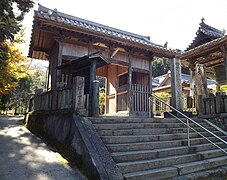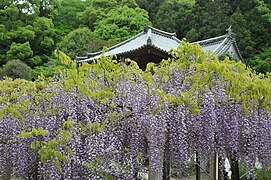Fujii-dera (Yoshinogawa)
The Fujii-dera ( Japanese 藤井 寺 ) with the Go Kongōzan (金剛山) and Ichijōin (一 乗 院) in Yoshinogawa ( Tokushima Prefecture ) is a temple in the mountains above the Yoshino River, which leads to the Myōshinji direction (妙 心 寺 派) of Rinzai Buddhism. In the traditional count, it is the 11th temple on the Shikoku pilgrimage route .
history
According to tradition, priest Kūkai came on his hike ( 巡 錫 , Junshaku) through Shikoku during the Kōnin era (810-824) in this area. He carved a figure of the healing Buddha Yakushi and built a small pavilion for him and built for it so-called "indestructible" ( 金剛 不 壞 , Kongōfue) as a Goma pedestal ( 護 摩 壇 ). And because he planted a five-color wisteria in the building , the temple is said to have been named Kongōsan Fujiidera.
At that time the temple belonged to the Shingon direction of Buddhism, but burned down in the armed conflicts during the Tenshō era (1573–1592). Priest Chōzen ( 澄 禅 ) from Chishakuin ( 知 積 院 ) in Kyoto, who visited the area in 1653, reported that the temple was devastated. Finally, the temple was rebuilt during the Enpo era (1673-1682) by priest Nanzan ( 南山 ) as a temple of the Rinzai direction.
In 1832 the temple burned again, whereby only the Buddha, the cult figure, could be saved. Reconstruction began in 1869.
The attachment
One enters the complex through the temple gate (山門, Sammon; 1), then comes to the main hall (本 堂, Hondō; 2) and then on the right is the hall in which the temple founder is venerated, the Daishidō (大師 堂; 3). Behind the temple grounds, a little higher, is the small octagonal pavilion Hakuryū Benzaitendō (白龍 弁 財 天堂; 4), which is dedicated to the holy Benzaiten .
Further above, Oku no In (奥 の 院) is a tiny shrine on a slate-like stone layer.
Treasures
The main cult figure is a sculpture of the Yakushi Buddha, i.e. the healing Buddha. On the back there is an inscription in black, from which it can be seen that according to the priest Keijin (経 尋; 1499-1526) the figure was made as Shaka-Buddha in 1148. It is also referred to as such under the name "Mokuzō Shaka Nyorai zazō" (木造 釈 迦 如 来 坐像), as a "Made of wood, seated Shaka Nyorai figure" as an important cultural asset of Japan . The medicine jar that the present Buddha holds in his left hand was added later.
photos
literature
- Tokushima-ken no rekishi sampo henshu iinkai (Ed.): Fujii-dera . In: Tokushima-ken no rekishi sampo. Yamakawa Shuppan, 2009. ISBN 978-4-634-24636-2 . Page 109, 110.
- Oguri, Doei: Kukai. Shikoku hachijuhachi kosho no arukikata. Chukei no Bunko, 2011. ISBN 978-4-8061-4067-2 .
Web links
Coordinates: 34 ° 3 '6 " N , 134 ° 20' 54.6" E
← Previous Temple: Kirihata-ji | Fujii-dera (Yoshinogawa) | Next temple: Shōzan-ji →






